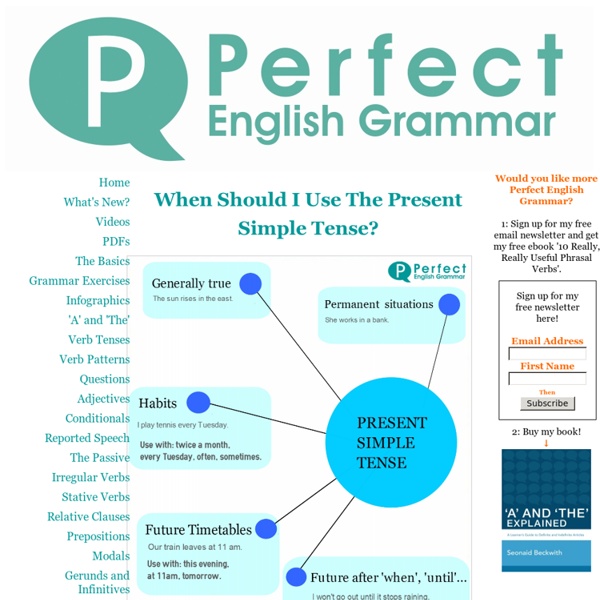Form
(Download this explanation in PDF) We need to use the Present Simple a lot in English, so it's really important to understand it well. Many students have problems with the form (or how to make it). If you'd prefer to learn about how to USE the Present Simple jump to this page.Or, click here for all the practice exercises about this tense. Simple present tense with 'be' The verb 'be' is different from the other verbs in this tense. Here's the positive form (positive means a normal sentence, not a negative or a question. Click here to practise making the positive with 'be'. Next, here's the negative. Click here to practise making the negative with 'be'. And finally let's talk about the question form of the present simple with 'be'. Firstly, here's the 'yes / no' question form: Click here to practise making yes / no questions with 'be'. If you'd like to make a 'wh' question, you just put the question word at the front: Click here to practise making 'wh' questions with 'be' . Don't forget the 's'!
Adverbs of Frequency Hangman Game - Always, Sometimes, Never, often
ESL Interactive Fun Games Here we have the games carefully laid out for you. Follow the links to browse the variety of games offered. Grammar Games & Interactive Exercises - Click Here! Games for Practising Grammar: Present simple/present progressive games, past tense games, present perfect games, comparative/Superlatives and more... Vocabulary Games & Interactive Exercises - Click Here! Games for practising English vocabulary: Lots of games by topics and game types Pronunciation Games & Interactive Exercises - Click Here! Games to practice English pronunciation, phonetics and phonics. Reading/Spelling Games & Interactive Exercises - Click Here! Games and exercises to practice reading, spelling and lexis
Present Simple Exercise 1
Here's an exercise where you need to make the present simple positive. Click here to review how to make the present simple tense.Click here to download this exercise in PDF (with answers)Click here for more present simple exercises Don't forget the 's'! Learning English as a foreign language: Tip #1 Read often in English. Click here for more present simple exercises
Present Simple Exercise 4
Here's another negative present simple exercise - type the whole sentence into the box and click 'check'. Click here to review how to make the present simpleClick here for another exercise about making the present simple negativeClick here to download this exercise in PDF (with answers) Learning English as a foreign language: Tip #4 Do grammar exercises about the English verb tenses until you feel really confident about how to make the tense. Click here for more present simple exercises
Present Simple Exercise 2
Here's an exercise where you need to make the present simple negative. Click here to review how to make the present simple. Click here to download this exercise in PDF (with answers)Click here for more present simple exercises Learning English as a foreign language: Tip #3 Try reading a newspaper in English - there will be a lot of difficult words, it's true, but don't try to read the whole thing at once. Click here for more present simple exercises
Present Simple Grammar and Sentences Interactive Grammar Game
Practice Present Simple Grammar and Sentences with this ESL Vocabulary and Grammar Interactive Monkey Fun Game for Beginners (sings, listens, etc). ESL Learners and Teachers can use it to review English vocabulary and grammar or simply practice these words. The present simple tense is often used for habitual or regular actions. We often use time expressions like 'Everyday, every morning, often, usually' being used with the present simple tense. There are images and in some cases audio in these types of games. Drag and drop the words into the correct spaces to complete the sentence. Games are great for motivating students to learn. More Games
Present Simple Exercise 2
Here's another exercise where you need to make the present simple positive. Click here to review how to make this tense.Click here to download this exercise in PDF (with answers)Click here for another present simple positive exercise. Don't forget the 's'! Learning English as a foreign language: Tip #2 Watch films and TV in English. Try another exercise about the simple present here Return to the grammar exercises page
Present Simple Tense Verbs Hangman Game
ESL Interactive Fun Games Here we have the games carefully laid out for you. Follow the links to browse the variety of games offered. This is only the directory for interactive games and exercises. Our ESL fun games here include : Snakes and Ladders, Hangman, Spelling games, Wheel of Fortune, TV Games(Betting Game), Mazes, Memory Games, Matching exercises, Sequencing exercises, Picture Quizzes, Catch it and more. These games provide the ultimate fun in practising the following skills: Grammar Games & Interactive Exercises - Click Here! Games for Practising Grammar: Present simple/present progressive games, past tense games, present perfect games, comparative/Superlatives and more... Vocabulary Games & Interactive Exercises - Click Here! Games for practising English vocabulary: Lots of games by topics and game types Pronunciation Games & Interactive Exercises - Click Here! Games to practice English pronunciation, phonetics and phonics. Games and exercises to practice reading, spelling and lexis



